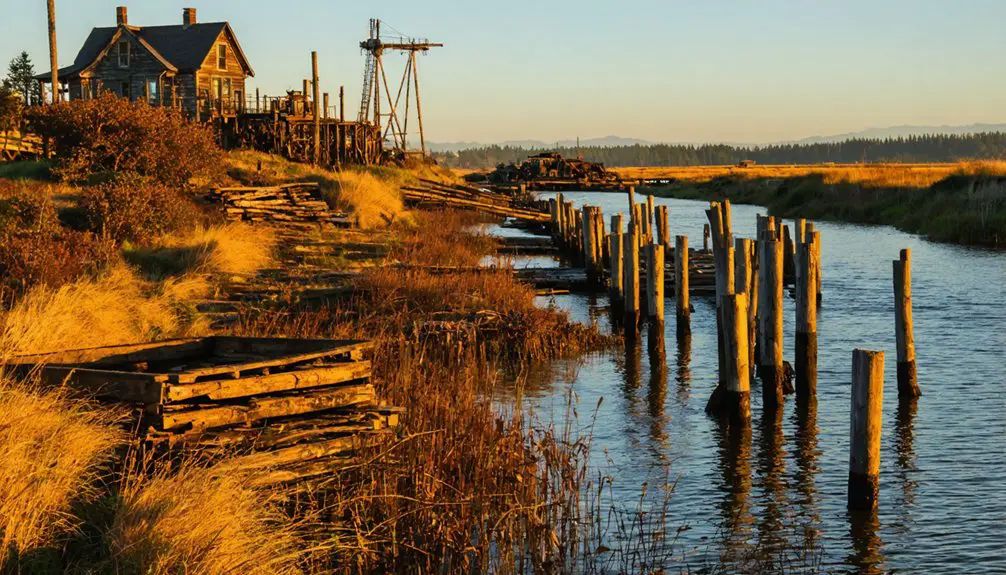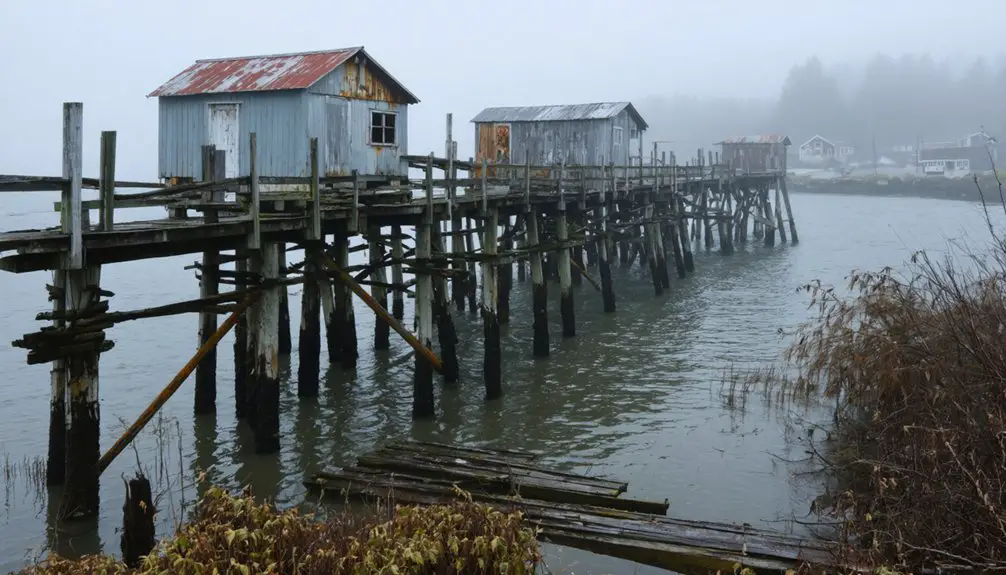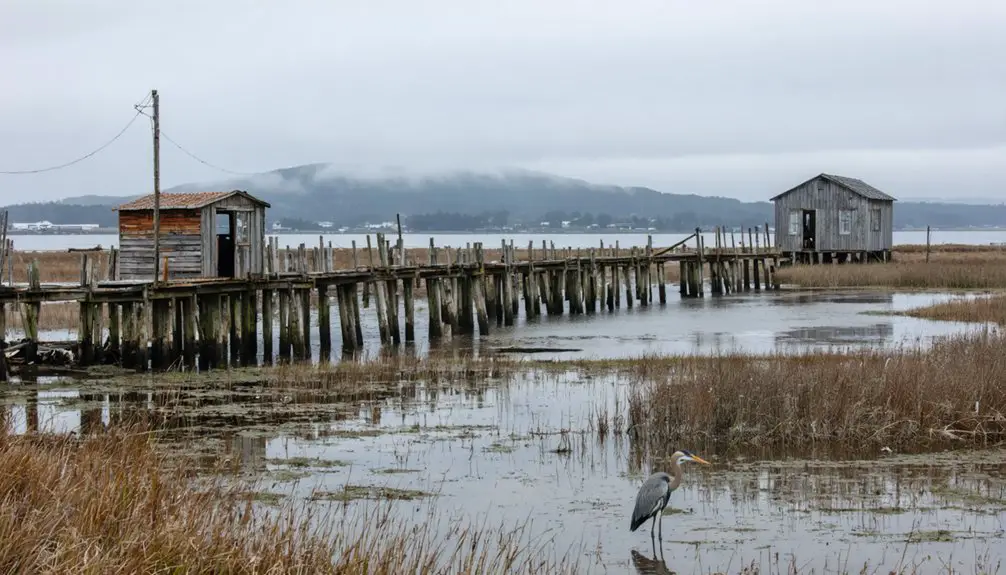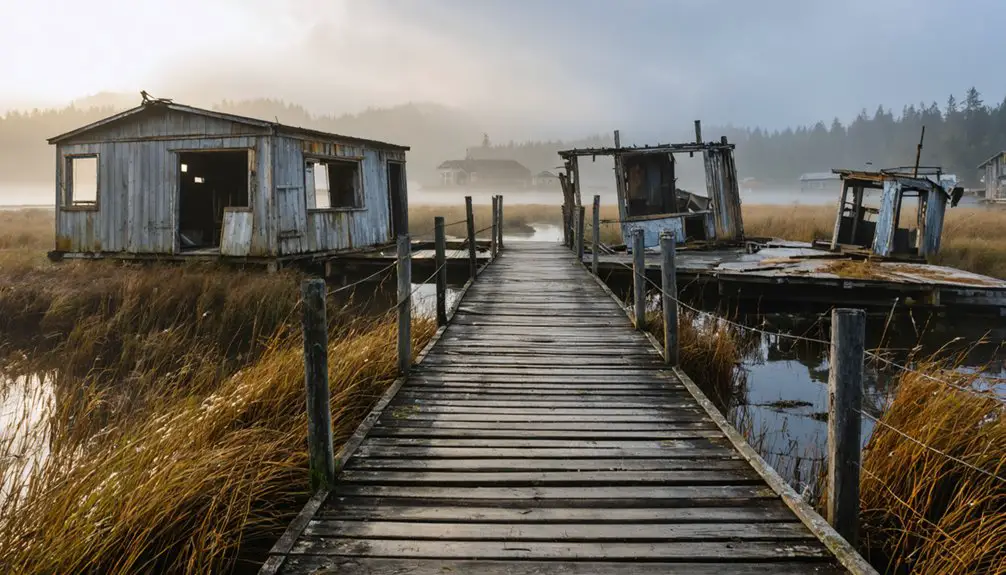You’ll find Southport among Oregon’s fascinating ghost towns near Coos Bay, where it thrived as a coal mining settlement in the 1870s. The town’s strategic location and rich coal deposits fueled its rapid growth, with the Southport Land and Commercial Company establishing essential infrastructure. After decades of prosperity, the community voted for disincorporation in 1926, with 15 of 16 voters choosing dissolution. The site’s abandoned remnants tell a deeper story of boom-and-bust frontier economics.
Key Takeaways
- Southport was a thriving coal mining town near Coos Bay, Oregon that became a ghost town after disincorporation in 1926.
- The town’s fate was sealed when 15 out of 16 voters chose to dissolve the community, leading to its abandonment.
- Economic decline began as younger residents left for opportunities elsewhere and local mining and logging operations dwindled.
- The Southport Mine was crucial to local prosperity through World War II before resource depletion contributed to the town’s downfall.
- Transportation isolation and deteriorating infrastructure hastened Southport’s abandonment after new routes bypassed the area.
The Birth of a Frontier Settlement
While the Pacific Northwest witnessed numerous frontier settlements in the mid-1800s, Southport emerged as a strategic outpost near Oregon’s Coos Bay region.
You’ll find its roots in Charles Merchant’s vision, who carefully platted the town to maximize its natural advantages. Despite pioneer challenges, the settlement’s location proved ideal – nestled among waterways that would serve as crucial arteries for trade and resource extraction.
The town’s early inhabitants faced the raw frontier with remarkable community resilience, transforming untamed land into a bustling hub for logging, mining, and shipping operations. Much like the three surviving buildings in Buncom, Southport’s remaining structures tell the story of its pioneering past.
Settlers from California and beyond made their way to Southport, drawn by abundant opportunities in coal mining and timber. The settlement’s thoughtful layout, complete with docks and commercial districts, supported the growing population of miners, loggers, and merchants who’d call this frontier town home. The Southport Land and Commercial Company invested heavily in the region, providing a crucial loan to expand railroad transportation to the mines.
Early Pioneer Life and Community Growth
You’ll find that Southport’s earliest pioneer families established themselves in clusters along fertile lands near water sources, following typical Oregon settlement patterns of the mid-1800s.
The families relied heavily on ferries at crossings to transport their goods and maintain connections with other settlements. Their success depended heavily on building trade networks to exchange agricultural goods, timber, and fish with neighboring communities and passing ships. Like the generous spirit shown by George Washington Bush during the difficult year of 1852’s hard times, these early settlers often shared resources to help their neighbors survive and thrive.
These resourceful settlers had to navigate complex social dynamics, including interactions with Native populations and other pioneers, while working to establish sustainable livelihoods in their new coastal home.
Pioneer Family Settlement Patterns
As pioneers ventured into Oregon’s southern coast in the early 1850s, European settler families established their first foothold near what would become Southport, clustering around resource-rich waterways and promising mining sites.
You’d find these hardy families working together, with pioneer family dynamics revolving around shared labor and mutual support. Multiple generations lived under one roof, pooling their resources and skills to survive the frontier challenges. During the challenging winter of 1870-1871, settlers survived on meals of potatoes due to scarce cash and limited store supplies. A well-known member of the community, Louis Southworth, operated a busy ferry across the Alsea River for three decades.
Settlement expansion followed a careful pattern, with families strategically choosing locations based on natural resources, defensive positions, and proximity to trade routes.
They’d often form tight-knit communities through intermarriage, strengthening their social bonds and property claims. While men focused on mining, logging, and trading, women managed households and helped build community institutions, creating a foundation for lasting settlement.
Frontier Resource Trade Network
The lifeblood of pioneer settlement flowed through an intricate network of trading posts and supply hubs stretching from Missouri to Oregon’s coast.
You’d find important forts like Ft. Laramie and Ft. Bridger serving as critical waypoints where you could restock supplies, repair wagons, and exchange goods with both merchants and Native Americans.
Trading post interactions weren’t just about commerce – they formed the backbone of pioneer survival. You could barter for fresh game, salmon, and vegetables, while strategic resource exchange dynamics helped reduce the burden of carrying everything from your starting point.
As these networks evolved, you’d see entrepreneurs establishing ferries and new routes, while freighting services began breaking long supply chains into manageable segments. The journey was arduous, taking four to six months to complete by wagon train.
This infrastructure became indispensable to building sustainable frontier communities. Emigrants needed to budget wisely, as a typical journey required $500 minimum for essential supplies and equipment.
Economic Forces Behind Southport’s Rise
During the 1850s, gold discoveries in Oregon’s Illinois River Valley sparked Southport’s transformation from untamed wilderness into a bustling economic hub.
You’ll find that mining technology and economic cycles played significant roles in shaping the town’s rapid growth, with the Southport Mine becoming a cornerstone of local prosperity through World War II.
The town’s economic liveliness stemmed from several key factors:
- The rich coal deposits that attracted steady employment and supported railroad development
- A strategic position as a supply center, providing essential services to surrounding mining camps
- The emergence of diverse commercial activities, from lodging to postal services
- A dynamic labor market that drew both temporary miners and permanent residents
This convergence of resources, commerce, and workforce created a thriving frontier economy that would define Southport’s golden era. Similar to Oregon’s wool capital Shaniko, the town’s prosperity relied heavily on a single industry.
Like other settlements in the region, the discovery of new gold strikes frequently prompted miners to abandon existing camps in search of better opportunities.
Transportation and Trade Routes
You’ll find Southport’s early success was deeply tied to its prime location along Coos Bay, where the natural deep-water channel provided essential access to the Pacific Ocean.
The harbor’s infrastructure evolved markedly, with dredging efforts by 1912 creating 25-foot-deep channels and turning basins that enhanced ship navigation and cargo handling capabilities.
Your understanding of Southport’s maritime prominence wouldn’t be complete without noting how the port served as a critical export hub for lumber, agricultural products, and maritime goods, connecting inland production to oceanic trade routes.
River Access Routes
Essential waterways surrounding Southport, Oregon created a network of natural transportation corridors that shaped the town’s early development and commerce.
You’ll find the Coquille River served as the lifeline for river navigation, connecting this frontier settlement to major markets along the Pacific Coast.
The natural trade dynamics flowed through several key water routes:
- The Coquille River system, including Isthmus and Beaver Sloughs, provided natural pathways for moving heavy cargo
- Native American canoe routes established time-tested navigation patterns through the region’s waterways
- Small steamboats and freight vessels transported coal and timber downstream without requiring extensive infrastructure
- River access points linked to coastal shipping lanes, connecting Southport’s resources to San Francisco, Portland, and Seattle markets
Port Infrastructure Development
While Southport’s early maritime trade relied heavily on river access, major infrastructure developments in the early 1900s transformed the region’s transportation landscape.
You’d have witnessed significant port development when the Southern Pacific Railroad gained control of regional lines in 1906, followed by the vital Eugene-to-Coos Bay connection completed in 1916.
The infrastructure impact expanded further in 1912 when the Port of Coos Bay issued $300,000 in bonds for harbor improvements, including channel dredging to 25-foot depths and new turning basins for larger vessels.
This coincided with the emergence of Reedsport as a railroad town, shifting trade patterns away from hazardous river routes.
The integrated rail-marine network you see today stems from these early 20th-century investments in multimodal transportation infrastructure.
Key Historical Events and Milestones

During the late 19th century, Southport emerged as a thriving coal mining settlement near Coos Bay, marking its place in Oregon’s industrial history. The town’s mining technology and community dynamics centered around the Southport Mine, which drove the area’s rapid development and prosperity.
Key milestones in Southport’s history include:
- The establishment and leasing of critical infrastructure by the Southport Land and Commercial Company, including the mine, railroad, and wharf.
- A period of significant growth and commercial success during the 1870s, outperforming nearby operations like the Black Diamond Mine.
- The town’s peak development phase, featuring extensive underground tunneling and sophisticated coal extraction methods.
- The dramatic decline by the mid-1920s, culminating in the town’s disincorporation in 1926 when 15 of 16 remaining voters chose to dissolve the municipality.
Natural Resources and Industry
The natural resources of Southport shaped both its rise and eventual downfall as a settlement.
You’ll find that coal deposits in the Coos Bay region were the primary driver of the town’s economy, with the Black Diamond Coal Mining Company establishing significant operations there. Their mining techniques focused on underground extraction, supported by the area’s timber resources.
While coal dominated Southport’s resource management, the surrounding forests provided essential lumber for both mining infrastructure and export. The town’s strategic location near waterways made transporting these resources efficient.
However, the intensive extraction of both coal and timber ultimately proved unsustainable. Environmental challenges, including soil and water contamination from mining activities, combined with resource depletion, contributed to Southport’s transformation into a ghost town.
The Path to Abandonment

As Southport’s resource-dependent economy began faltering in the late 19th century, a cascade of interconnected factors sealed its fate.
The town’s economic vulnerability became apparent as logging operations dwindled and transportation routes shifted elsewhere, leaving residents with few employment options.
You’ll find that several key elements contributed to Southport’s abandonment:
- Demographic shifts as younger generations sought opportunities in more prosperous regions
- Environmental impact from resource depletion that made economic recovery impossible
- Infrastructure decline when maintaining roads, schools, and services became unsustainable
- Transportation isolation after new routes bypassed the community
Without diversified industries to sustain its population, Southport couldn’t overcome these challenges.
The harsh realities of its geographic location and depleted resources ultimately transformed this once-thriving community into another Oregon ghost town.
Remnants and Physical Evidence Today
Physical remnants of Southport’s past can still be found scattered across its former townsite, though time and nature have taken their toll.
You’ll find weathered wooden structures, including what’s left of residential buildings and community spaces, standing as silent witnesses to the town’s mining era. Archaeological evidence reveals glimpses of daily life through discarded mining tools, household items, and religious artifacts, though many sites have been disturbed by looters over the years.
Crumbling remnants tell tales of frontier life, while looters slowly erase the archaeological record of Southport’s mining heritage.
The landscape itself tells part of the story, with abandoned mine shafts, tailings piles, and stripped hillsides marking where prospectors once sought their fortunes.
While nearby creeks and wetlands have reclaimed much of the area, you can still trace old roads and town plots beneath the encroaching forest, offering a window into Southport’s forgotten chapters.
Historical Legacy in Oregon’s Coastal Region

Beyond these weathered remnants lies Southport’s broader significance in Oregon’s coastal narrative. You’ll find this ghost town’s story deeply woven into the region’s cultural heritage, representing a classic example of the boom-and-bust cycles that shaped Oregon’s development during the 19th century.
- As one of Oregon’s 200+ ghost towns, Southport exemplifies the dramatic economic shifts that transformed coastal communities.
- You can trace the town’s connection to a broader network of mining settlements, including Nortonville and Coos City.
- The site stands as a symbol of the resilient spirit of frontier communities and their adaptability.
- Through ghost town preservation efforts, you’re able to glimpse how resource extraction industries influenced settlement patterns along Oregon’s coast.
Frequently Asked Questions
Are There Any Paranormal or Ghost Stories Associated With Southport?
You won’t find documented ghost sightings or haunted locations in Southport’s history. Unlike other Oregon ghost towns with rich paranormal folklore, there aren’t any verified supernatural stories from this former mining town.
What Native American Tribes Originally Inhabited the Southport Area?
You’ll find that the Coos, Lower Umpqua, and Siuslaw tribes, rich in Indigenous history and Tribal culture, called this land home for thousands of years before European settlement disrupted their communities.
Can Visitors Legally Explore the Former Southport Town Site Today?
You can’t freely explore the site due to unclear visitor access and legal restrictions. Without definitive ownership information, you’ll need to verify permissions and potential trespassing laws before attempting any visits.
What Happened to Southport’s Cemetery and Burial Grounds?
Time stands still at the Old Smithville Burying Ground, where you’ll find 1,093 documented burials dating to the 1700s. The cemetery’s history remains preserved through local volunteers’ dedicated restoration and documentation efforts.
Were There Any Notable Crimes or Lawlessness During Southport’s Peak Years?
You won’t find reliable crime statistics or detailed law enforcement records from Southport’s peak years. While minor disputes likely occurred in saloons, there’s no documented evidence of significant lawlessness or notable crimes.
References
- https://www.travelmedford.org/southern-oregon-ghost-towns-
- https://kids.kiddle.co/List_of_ghost_towns_in_Oregon
- https://en.wikipedia.org/wiki/List_of_ghost_towns_in_Oregon
- https://cooshistory.org/wp-content/uploads/2023/06/Timeline-of-South-Coast-History_v2.pdf
- https://kids.kiddle.co/Southport
- http://www.southport-land.com/history.html
- https://traveloregon.com/things-to-do/culture-history/ghost-towns/oregon-ghost-towns-boyd-dufur-and-friend/
- https://historicoregoncity.org/2019/04/02/black-pioneers-and-settlers/
- https://en.wikipedia.org/wiki/Oregon_pioneer_history
- https://oregonblackpioneers.org/black-history-spotlight-louis-southworth/



